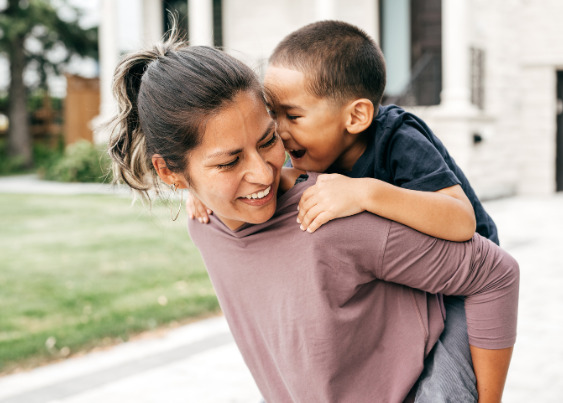In childbearing, attachment is a largely discussed topic. Attachment is defined as a bond that exists between a child and a parent with a purpose of establishing a safe, secure, and protective environment for the child (Beniot, 2004).

Most can agree that attachment is vital within the parent-child relationship. It is well researched that attachment within early childhood, beginning in infancy, plays a big role in the future emotional and social outcomes of an individual.
As a parent, you step into many roles as your child develops. These roles can range from teacher, friend, disciplinarian, and caregiver. It is within these roles attachment is developed and fostered.
Building Attachment Through Expressions of Love
Gary Chapman offers a foundation of how to build attachment with your child as your child grows into the self-sufficient adult you envision from the very beginning. Primarily applied to couples, he identifies five ways to express love to your partner. In the same sense, he extends this train of thought to expressing your love towards children.
Chapman identifies Physical Touch, Quality Time, Words of Affirmation, Acts of Service, and Gifts as expressions of love. While children in their own unique personality do tend towards one or two primary ways of wishing to receive love much like adults do, the difference between children and adults is how important it is that children experience all five expressions of love. It is through these continued expressions of love that attachment is created and reinforced over time.
Physical Touch
Hugs and kisses are one primary way children welcome physical touch. In infancy, a baby is snuggled, kissed, cooed at, and held frequently within the first year of life. As the child grows, it is equally as important to continue with physical touch despite moments when a child may look like they do not wish to receive it. Physical touch is one of the easiest love languages to express as it can often be used without reason.

What Does it Look Like?
- In a three-year-old, it may look like giving your child a piggyback ride.
- In a seven-year-old, it may look like tickling and wrestling with your child.
- In a 14-year-old, it may look like sitting next to them while patting and rubbing their back in a difficult time.
Physical touch reminds your child that you are physically there to help support and encourage them. It offers far more substance than just words alone and reinforces the bond that began in infancy.
Words of Affirmation
When communicating love, words can be powerful. Words of affirmation, affection, and endearment all express care for another person. Receiving words of affirmation helps build security and self-worth in an individual.

Sending the message of “I love you, and I care about you” to your child without added conditions is vital. Providing support to your child can be broken down by encouraging words, positive comments, praising words, and loving guidance.
Encouraging words help provide motivation in a child. An example of encouraging words includes “That’s close, you’ve almost got it!” Whereas, positive comments are used to help build confidence about oneself; an example of positive comments may sound like, “Your hair is really beautiful” or “You look very handsome.”
Praising words focus more on the child’s capabilities, and a message may sound like, “You did really great on your math test today.” When providing loving guidance, it is important to focus on the love and concern behind the message rather than the specific choice they made. An example of this may include, “I am worried about your safety when you miss your curfew, and I want to know you are home safe.”
Overall, it is vital to communicate positive messages to children as these messages are foundational blocks to building security and self-worth. Most importantly, these positive messages further strengthen communication and attachment within the parent-child relationship.
Quality Time
In a world where everything seems to run in overdrive, we can often forget to spend time with others, including children, leaving behind deadlines, structure, and routines. Undivided attention is one of the best ways you can provide your child with quality time.

Allowing your child to choose and, most importantly, lead play with you is key. Immersing yourself into your child’s imaginative play and allowing yourself to be fully present is an immeasurable gift to your child, even if it is only for 15 minutes before you start your to-do list.
What Does it Look Like?
- In a six-year-old, it may look like playing with dolls or army figures together creating a shared story in play.
- In a ten-year-old, it may look like going outside and throwing a ball back and forth or shooting a basketball.
- ln a 15-year-old, it may look like a trip to the local coffee shop to get a favorite hot or cold beverage allowing for quality conversations to occur.
It is incredibly important to spend time with your child outside of your daily scheduled activities. It is within these quality moments your bond with your child is strengthened and reinforced.
Gifts
When expressing love through gifts, it does not necessarily mean showering your child with endless gifts. Often, gifts are to be given in conjunction with other love languages to help provide meaning and importance behind the gift.
Gifts, like Acts of Service, are not given with expectations or in exchange for something else. Gifts can be given throughout childhood and adolescence.

As a parent, it important to focus on the expression of love behind the gift, not the cost and size. This can help teach your child the meaning behind the gift rather than creating an expectation behind gift receiving.
Simply by wrapping back-to-school clothes and presenting this to your child as a gift can create thrill and excitement around something that is often normally done; or bringing a gift back from a work trip can help remind the child they were thought of while they were separated from the parent.
Not all gifts have to be bound in money. As long as the gift presented stimulates your child’s creativity, it will offer far more meaning than the newest, must-have item at the store. When gifts are given as expressions of love, it can further reinforce the loving bond that has been created over time.
Acts of Service
Frequently, there are many expectations placed on a child’s capability to complete a task. In reality, all individuals have different skill levels and unique abilities. In this love language, it is important to help children feel loved by receiving selfless acts of service.

Acts of Service are not considered acts that a child can complete independently, such as making your 8-year-old child’s bed every morning for them because you want it done a certain way. These acts are done with compassion and genuine love to help support a child with no strings attached.
The goal of this love language is to help a child build understanding around service and responsibility to others, which begins when they have that behavior modeled for them.
What Does it Look Like?
- In a five-year-old, this may look like spending time to teach your child how to ride a bike.
- In a 10-year-old, this may look more like helping them do their homework.
- In a 15-year-old, this may look like chauffeuring their child to all of their activities they participate in.
Over time, children will recognize the things their parents do for them. As a result, children will be able to return the gift of service to others who may need the extra support.
Getting Support to Foster Attachment
Each of these expressions of love help build and reinforce attachment as your child grows. When expressions of love are not given and received in effective manners, it can lead to a breakdown within the parent-child relationship resulting in feelings of stress, confusion, and frustration.
If you find that you and your child have difficulties communicating love consistently and effectively, Sunstone Counseling has therapists who can help families rebuild communication and re-establish the loving bond that exists between a parent and child. Contact us today to schedule an appointment with a therapist.
— Written by Sunstone counselor, Jennifer Munroe, LPC
References:
Benoit D. (2004). Infant-parent attachment: Definition, types, antecedents, measurement and outcome. Paediatrics & child health, 9(8), 541-545.
Chapman, G., & Campbell, R. (1997). The 5 Love Languages of Children. Chicago, IL: Northfield Publishing.
